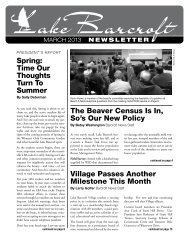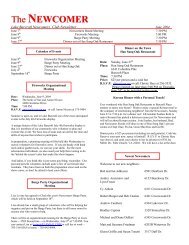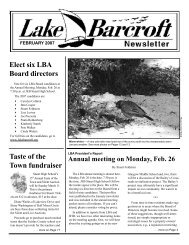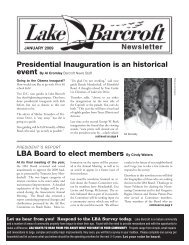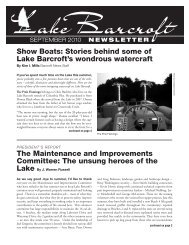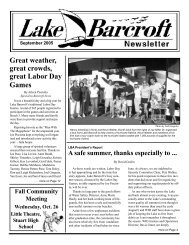Lake Barcroft History Book
Lake Barcroft History Book
Lake Barcroft History Book
Create successful ePaper yourself
Turn your PDF publications into a flip-book with our unique Google optimized e-Paper software.
As a prelude to the 50-year history of the <strong>Lake</strong> <strong>Barcroft</strong><br />
community, a portion of the <strong>Lake</strong> <strong>Barcroft</strong> Story is<br />
reprinted from the <strong>Lake</strong> <strong>Barcroft</strong> Directory. This is a<br />
synopsis of local area history up to 1950. It also contains some<br />
background on the person for whom <strong>Lake</strong> <strong>Barcroft</strong> is named.<br />
The <strong>Lake</strong> <strong>Barcroft</strong> Story<br />
BARCROFT COMMUNITY was named in memory of a<br />
doctor who built his home here and also operated a mill. The<br />
man was Dr. John W. <strong>Barcroft</strong>, originally from New Jersey. In<br />
1849, Dr. <strong>Barcroft</strong> came to our area and built both a home<br />
and a mill on Columbia Pike at Holmes Run near the present<br />
dam. He practiced medicine throughout the surrounding<br />
community and ran his mill up to the time of the Civil War.<br />
During its retreat from the Battle of Bull Run, the Union<br />
Army overran Dr. <strong>Barcroft</strong>’s home. His property was so<br />
damaged that he went back North until the end of the war.<br />
He then returned to Fairfax County and built a new home on<br />
what became known as <strong>Barcroft</strong> Hill.<br />
Before the time of Dr. <strong>Barcroft</strong>, our neighborhood was not<br />
without some notable history. The original residents were the<br />
Doe and Necostin Indians of the Algonquin tribes. (Anacostia<br />
derives its name from the Necostins.) Artifacts of these early<br />
natives are still occasionally found. Howard Uphoff has<br />
uncovered arrowheads on his land at 6308 <strong>Lake</strong>view Drive.<br />
Munson Hill Farm was a large tract between what is now<br />
Bailey’s Crossroads and Seven Corners. It was settled and<br />
developed during the early 1700’s. Timothy Munson bought<br />
the land in 1851 and gave his name to the farm. In the time to<br />
come, his name was also applied to a community and a street<br />
just north of our lake area. Columbia Pike was constructed as a<br />
toll road in 1808, and was then called the Washington<br />
Graveled Road.<br />
During the Civil War, both Munson Hill Farm and Bailey’s<br />
Crossroads were scenes of action. At the beginning of the war<br />
Bailey’s Crossroads was a Union Army camp. At the same time,<br />
the Confederate Army occupied locations at Annandale and<br />
Fairfax. Later, federal troops built Fort Buffalo at the present<br />
site of Seven Corners, and it became one of the ring of forts<br />
protecting the District of Columbia in 1861. At about that<br />
time, Bailey’s Crossroads was the site of the largest military<br />
review ever held anywhere. General McClellan reviewed<br />
75,000 troops, and President Lincoln was among the<br />
additional 75,000 spectators who came to watch the Army of<br />
the Potomac’s vast parade.<br />
Introduction<br />
2<br />
It was during this grand review that Julia Ward Howe was<br />
inspired to write new words for the music of a song called John<br />
Brown’s Body. The new song became one of the most stirring<br />
anthems of all time, the Battle Hymn of the Republic.<br />
Bailey’s Crossroads is named for the Baileys, a circus owning<br />
family whose menagerie and shows were merged with those of<br />
P. T. Barnum about 1870. The Barnum and Bailey Circus was<br />
then billed as, “The Greatest Show on Earth.” For many years,<br />
Bailey’s Crossroads was its winter quarters.<br />
<strong>Lake</strong> <strong>Barcroft</strong> came into being in 1915. An increasing need for<br />
water by the City of Alexandria led the Alexandria Water<br />
Company to build the dam and establish a reservoir to store<br />
the waters from the branches of Holmes Run. The North<br />
Branch of Holmes Run is now called Tripps Run.<br />
Dam construction was begun in 1913 under contract with the<br />
Piedmont Construction Company. Specifications for the<br />
<strong>Barcroft</strong> Dam were severe and the construction was massive.<br />
The structure is of cyclopean masonry and concrete. The<br />
foundation is laid upon bedrock. A railway was built to<br />
transport the masonry stones to the dam site. The contractor<br />
went broke completing the job.<br />
The result was a dam 400 feet wide with the spillway at the<br />
top 205 feet above mean sea level and 63 feet above the<br />
streambed. Behind this dam, there formed a lake of 115 acres<br />
and over five miles of shoreline. When full it held nearly<br />
620,000,000 gallons and had an average daily runoff of about<br />
10,000,000 gallons. In 1942, gates were installed at the top of<br />
the dam to raise the spillway level five feet. This increased the<br />
size of the reservoir to 135 acres and the capacity to about<br />
800,000,000 gallons.<br />
In the late 1940’s, the reservoir became too small to serve<br />
Alexandria and other water sources replaced its use. In 1950<br />
the reservoir and its surrounding land were put up for sale by<br />
the Water Company. There was a movement to turn it into a<br />
Fairfax County park, but the Board of Supervisors considered<br />
the economics and decided in favor of private development.<br />
A partnership of developers from Boston bought the lake<br />
and 680 acres of land in the spring of 1950 for about one<br />
million dollars.<br />
Adapted from “<strong>Lake</strong> <strong>Barcroft</strong> Origins” by Will Fazar, <strong>Lake</strong> <strong>Barcroft</strong> Directory<br />
1967, and “Some Virginia <strong>History</strong>” by Rex Lauck, <strong>Lake</strong> <strong>Barcroft</strong> Directory<br />
1970. Revised, 1974 & 1979, by Myron Birnbaum. Revised, 1992 by<br />
William Lowenthal.



